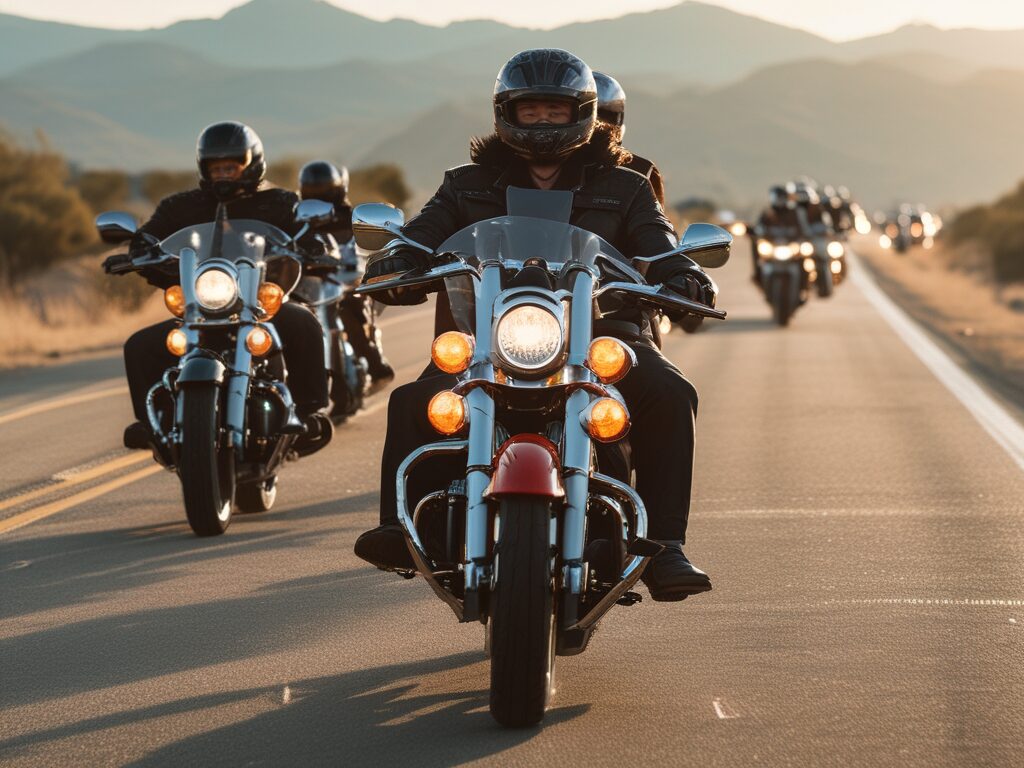By James “Hollywood” Macecari
At least 17 injured in chain-reaction motorcycle crash in Fort Worth, police say
Little details are coming out right now with this incident. Some are saying that one of the lead bikes blew a tire, went down and it was a chain reaction. It looks like many of the bikes were sport bikes. Check out the aftermath, bikes were on fire all over the place.
I cannot speak for what happened, I can only go off what the news is saying. What I can tell you is there is ways to avoid this kind of accident.
You have to maintain your distance
You have to learn what distance you’re comfortable with when riding in a pack. Sure, when I was younger I thought it was so cool to ride deuce, (side by side) but in reality it’s one of the most dangerous and stupid ways to ride.
You have to learn your comfort zone. Don’t ever let anyone put you in a position where you don’t feel comfortable. This also includes if you’re in a motorcycle club. I know clubs that ride tire to tire. Riding like that is going to cause a chain reaction just like this incident. When I was in a motorcycle club I would always ride in the very back. I would never ride in the front or middle. Sure, I had the guys always ragging on me but I never cared. If something happened I wanted time to be able to avoid everyone else.
This is the same while on the street with other vehicles. I never ride directly side by side with another vehicle. I prefer staying behind them if they’re going about the same speed I am. But if I have to pass them I do it right away and make sure to put distance between us. When you’re on a motorcycle these cars and trucks can’t see you. Next thing you know they’re switching lanes right into you.
Stay out of packs of motorcycles if you don’t know the people riding
I will never ever ride in a pack or in proximity of for example, HOG or charity runs. I don’t know any of those peoples experience level. It actually scares the shit out of me when I see some of those packs pulling out of the parking lot.
If you’re going to go on a ride where a lot of people are going to be involved – meet them at the end spot. Or, like I will do, stay about 100 feet from the back of the pack. There is just to many variables in a situation like this turn into a disaster.
I know, most of these events have a safety officer. That safety officer doesn’t mean shit when you’re all riding.. I don’t care if they have safety meetings multiple times before a ride, too many things can happen on that road.
I would say if you’re carrying a passenger this has to be one of the most important things to do. You’re not only have your life to worry about, now you have someone else’s to worry about. If you think you’re on high alert riding alone with a passenger by yourselves. It doubles or triples when you’re in a pack.
The Appeal—and Risk—of Group Riding
Riding with a group can be thrilling. There’s a deep sense of brotherhood and unity as engines rumble in unison and bikes sweep along the open road together. But this shared experience comes with risks. Group dynamics inherently reduce reaction time, limit maneuvering space, and make it easier for one rider’s mistake—or a mechanical issue, as in this case—to affect many.
The Fort Worth crash is a textbook example of how quickly things can go wrong. It started with a tire blowout—an unfortunate yet fairly common mechanical issue. But because of the close quarters in a group formation, there was little time or room for other riders to react. The result was a cascading series of collisions that left dozens of riders and their machines sprawled across the highway.
What Went Wrong?
According to investigators, a key contributing factor was how tightly the group was riding. When motorcycles are too close together, there’s minimal reaction time if something unexpected happens. The crash quickly turned into a fire hazard, with several bikes erupting in flames, adding another layer of danger to an already volatile situation.
Emergency crews praised bystanders and fellow riders who stopped to help pull the injured from the wreckage before firefighters arrived. Their quick action likely saved lives. But no amount of heroism after the fact can replace the importance of prevention.
How Riders Can Protect Themselves in a Group Final Thoughts
If you ride in groups, understanding and following group riding safety protocols can make the difference between a joyful ride and a life-threatening pileup. Here are key strategies to avoid going down with the pack:
1. Conduct a Full Pre-Ride Inspection
Before any group ride, every rider should do a complete check of their motorcycle. This includes tire pressure and tread, brakes, oil, coolant, and lights. The tire blowout that triggered the Fort Worth crash might have been unavoidable, but regular inspections often catch issues before they become dangerous.
2. Staggered Formation Over Side-by-Side
Many accidents in group rides stem from poor formation. A staggered formation—where the lead rider is in the left third of the lane, the second in the right third, and so on—gives each rider a better field of view and more space to maneuver. Avoid riding directly side-by-side, as it limits escape options if a hazard appears.
3. Keep a Safe Following Distance
The general rule of thumb is a minimum two-second gap between you and the bike directly in front of you. For staggered riders, this becomes about a one-second gap from the rider ahead on the opposite side of the lane. If you’re tailgating, even a minor slowdown could lead to a crash.
4. Communicate Clearly
Group riders should agree on hand signals before heading out. Using standardized signals for slowing down, stopping, hazards in the road, or mechanical issues helps everyone stay informed and safe. Riders with Bluetooth headsets can take this further with real-time verbal communication.
5. Ride Within Your Skill Level
The group should always move at a pace that matches the least experienced rider. No one should feel pressured to ride faster or take turns more aggressively than they’re comfortable with. Pushing beyond your abilities puts everyone at risk.
6. Designate Lead and Sweep Riders
The lead sets the pace and watches for road conditions, while the sweep rider (at the back) ensures no one gets left behind. These riders should be the most experienced in the group. They are responsible for coordinating stops, handling emergencies, and maintaining group cohesion.
7. Take Regular Breaks
Fatigue is a silent killer. Group rides often span hours and hundreds of miles. Schedule regular stops for hydration, stretching, and rest. Tired riders are more prone to make mistakes or miss critical hazards.
8. Gear Up
In the Fort Worth incident, protective gear likely saved lives. Full-face helmets, armored jackets, gloves, and reinforced pants and boots dramatically reduce injury severity in crashes. Texas law allows riders over 21 to go without helmets under certain conditions, but that doesn’t make it a smart choice. Helmets save lives—full stop.
Final Thoughts
The Fort Worth chain-reaction crash is a grim reminder of just how vulnerable motorcyclists are, especially when riding in groups. While the open road offers freedom, it also demands responsibility. Riders must be proactive, not just reactive, when it comes to safety. Mechanical issues like tire blowouts are unpredictable, but how a group prepares, communicates, and rides together can make the difference between a close call and a catastrophic pileup.
By respecting the road, your machine, and your fellow riders, you can help ensure that your next group ride is a memory worth keeping—rather than one that ends in tragedy.
Sources:
21 people injured after motorcycle crash in Fort Worth, fire officials say
At least 17 injured in chain-reaction motorcycle crash in Fort Worth, police say
 https://amzn.to/427NN2J
https://amzn.to/427NN2J- Chain-reaction motorcycle crash in Fort Worth- How to Avoid Motorcycle Crash Risks in Groups
- HELLS ANGELS ON THE ASPHALT
- Pros and Cons of Joining an Outlaw 1% Motorcycle Club
- Toledo Buffalo Soldiers Motorcycle Club wants to ensure riders are safe
- 17 Injured in Multi-Motorcycle Crash in Texas: Mass Casualty Event



Leave a Reply